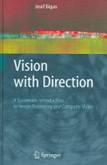|
FEATURE:
ICPR 2008 Invited Talk 6 |


|
Getting the Big Picture from the Small by (making) Sense of Direction
By Josef Bigun (Sweden) Reviewed by Vasant Manohar (USA) |
|
Directional signal processing, an increasingly crucial element of computer vision for which neural circuits exist in human vision, and its applications in various fields, such as biometrics, texture analysis, and content-based image retrieval, was the focus of the plenary session by Josef Bigun (Halmstad University, Sweden). After going through a few basic concepts on the perception of direction in the human visual system and in computer vision, Dr. Bigun described a set of complex differential operators that can be used to produce and filter dense orientation (tensor) fields for feature extraction, matching, and pattern recognition. The invariance properties of these operators, which he calls symmetry derivatives, have useful consequences for local orientation-based feature extraction with greater analytical precision as well as computational efficiency. In one of the applications, a robust alternative to conventional minutiae extraction for fingerprint recognition systems is proposed. The proposed parabolic symmetry features accurately detect the position and the direction of a minutia simultaneously. In order to quantify enhancement, the speaker presented results that showed lower matching errors even for a commercial grade matcher using the suggested pre-processing method. Further, Dr. Bigun suggested a novel identity authentication technique by a synergetic use of lip-motion and speech. The lip-motion is defined as the distribution of apparent velocities in the movement of intensity patterns in an image and is estimated by computing the velocity components of the structure tensor. Since the velocities are computed without extracting the subject's lip-contours, more robust visual features can be obtained in comparison to motion features extracted from lip-contours. Besides its value in authentication, the technique can be used naturally to evaluate the ‘‘liveness’’ of someone speaking as it can be used in a text-prompted dialogue. In essence, through a very informative lecture, Dr. Bigun described the symmetry derivatives, and, by means of multiple applications, he illustrated the interest and the usage of the associated theorems and lemmas in practical situations. |

|
For more details on the work by the speaker, visit
and
refer his book
(Springer, 2006) |
